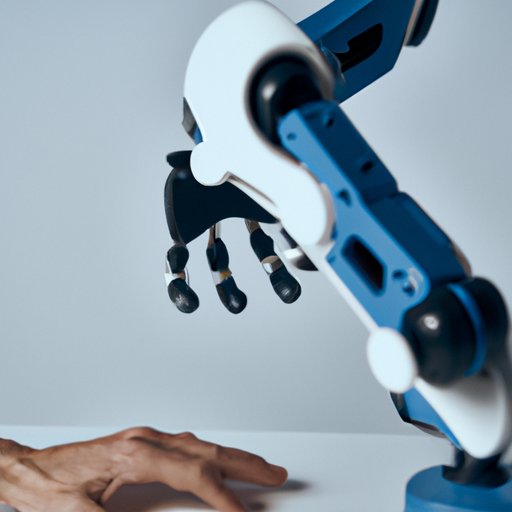Introduction
Robot manipulators, commonly referred to as robotic arms, are a type of robot that can be programmed to move and manipulate objects. They are used in a variety of industries, from manufacturing to medical applications, and are essential components of modern automated systems. In this article, we will explore what is a manipulator in robotics, including different types of manipulators, their applications, design considerations, and control systems. We will also discuss the complexities of manipulation tasks and the benefits and limitations of using manipulators in robotics.

Exploring the Role of Manipulators in Robotics
Robot manipulators are designed to move and interact with the environment in order to accomplish various tasks. They are typically composed of several joints connected by links, which allow them to move in multiple directions. Robot manipulators are often equipped with sensors and actuators, which provide feedback on the environment and enable precise control of the robot’s movements.
An Overview of Manipulator Types and Applications in Robotics
Robot manipulators come in a variety of shapes and sizes, depending on their intended application. Common types of manipulators include articulated (or jointed) arms, Cartesian robots, and SCARA robots. Articulated arms have rotary joints that allow them to move in multiple directions, while Cartesian robots use linear actuators to move along three axes. SCARA robots combine the features of both articulated and Cartesian robots, allowing them to move in two or three dimensions.
Robot manipulators are used in a variety of applications, such as assembly, welding, painting, pick-and-place operations, and material handling. They can be used in hazardous environments where humans cannot go, such as nuclear power plants, and are also used in medical applications, such as performing surgery or delivering drugs. Manipulators are also widely used in research, enabling scientists to study complex physical phenomena without putting humans at risk.
Robotics Manipulators: Design and Control
Designing a robot manipulator requires careful consideration of several factors, including the size and shape of the robot, the number of degrees of freedom (DOF), the type of actuators, the type of sensors, and the materials used. The design must take into account the robot’s intended application, as well as the environment in which it will operate. The robot must also be designed to withstand the forces it will encounter during operation.
The performance of a robot manipulator is largely determined by its control system. The control system is responsible for interpreting commands from the operator and translating them into instructions for the robot. The control system must be able to accurately interpret the commands and respond quickly and precisely to changes in the environment. Several control systems are available, including position control, velocity control, and force control.

Manipulation Tasks: Understanding the Complexities of Robotics Manipulators
Robotic manipulators are capable of performing complex manipulation tasks, such as grasping, sorting, and assembling objects. However, these tasks can be difficult to master, as they require the robot to accurately interpret the environment and make precise movements. To improve the performance of robotic manipulators, researchers have developed algorithms that allow the robot to learn from its mistakes and adapt to new situations.
“Robots are increasingly being used to automate processes that were previously done by humans,” says Dr. Karen Salisbury, professor of Robotics at the University of California, Berkeley. “These tasks require robots to interpret the environment and make decisions based on those interpretations. This is why mastering manipulation tasks is so challenging.”

The Benefits and Limitations of Manipulators in Robotics
Robotic manipulators offer numerous advantages over manual labor, including improved accuracy, repeatability, and speed. They are also more efficient than human labor, as they can work 24 hours a day without breaks. Additionally, robots can operate in hazardous environments without putting workers at risk.
Despite these advantages, there are some limitations to using robotic manipulators. For example, robots are limited by the complexity of their programming, and they cannot always make decisions or judgments in the same way a human can. Furthermore, robots are expensive to purchase and maintain, and they require considerable amounts of energy to operate.
Conclusion
In conclusion, robot manipulators are an essential component of modern automated systems, offering greater accuracy, repeatability, and efficiency than manual labor. Manipulators come in a variety of shapes and sizes, depending on their intended application, and they can be used in a variety of industries, from manufacturing to medical applications. While robotic manipulators offer numerous advantages over manual labor, they are limited by the complexity of their programming and the cost of purchasing and maintaining them.
Further study is needed to better understand the complexities of manipulating tasks and to develop strategies for improving the performance of robotic manipulators. Additionally, further research is needed to identify the most effective methods for controlling robotic manipulators and for integrating them into existing systems.
(Note: Is this article not meeting your expectations? Do you have knowledge or insights to share? Unlock new opportunities and expand your reach by joining our authors team. Click Registration to join us and share your expertise with our readers.)
